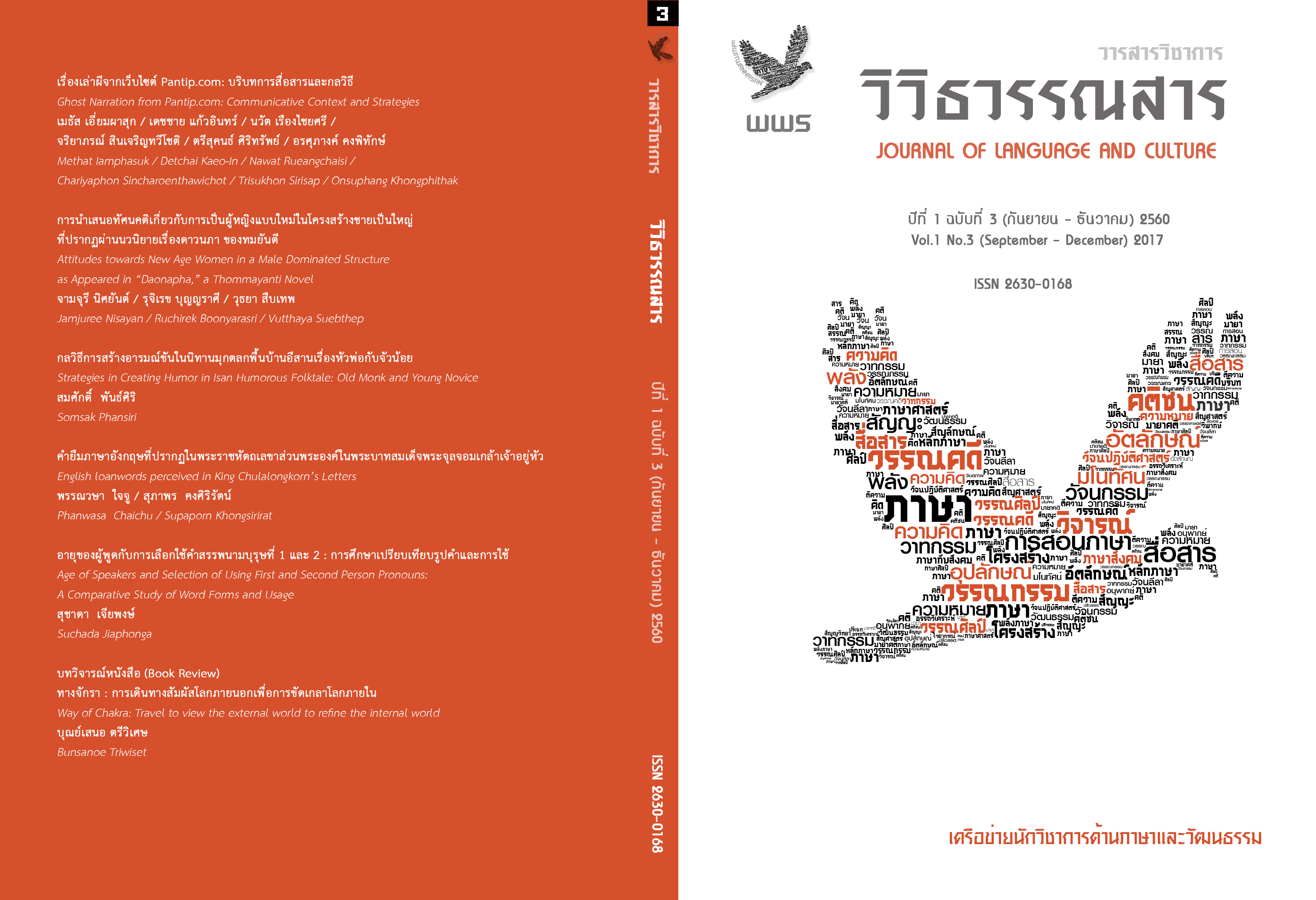อายุของผู้พูดกับการเลือกใช้คำสรรพนามบุรุษที่ 1 และ 2: การศึกษาเปรียบเทียบรูปคำและการใช้
Main Article Content
บทคัดย่อ
บทความนี้มีวัตถุประสงค์เพื่อ 1) ศึกษาเปรียบเทียบรูปคำสรรพนามบุรุษที่ 1 และบุรุษที่ 2 ของผู้พูดต่างอายุกัน และ 2) ศึกษาเปรียบเทียบการใช้ตามปัจจัยทางสังคมของคำสรรพนามบุรุษที่ 1 และบุรุษที่ 2 ของผู้พูดต่างอายุกัน ทั้งนี้เก็บข้อมูลโดยแบบสัมภาษณ์ผู้พูด 2 กลุ่มอายุ คือกลุ่มอายุน้อย อายุ 15-20 ปี จำนวน 50 คน และกลุ่มอายุมาก อายุ50-55 ปี จำนวน 50 คน ผลการศึกษาพบว่ารูปคำและการใช้ตามปัจจัยทางสังคมของคำสรรพนามบุรุษที่ 1 และบุรุษที่ 2 ในสถานการณ์การสื่อสารเดียวกัน ผู้พูดที่อายุต่างกัน ใช้คำบุรุษสรรพนามต่างกัน ทั้งในเรื่องจำนวนรูปคำ และความถี่ของการใช้คำ นอกจากนี้ยังสะท้อนแนวโน้มการใช้คำบุรุษสรรพนามที่เลือกใช้คำแสดงความให้เกียรติกันมากขึ้นและแสดงความเป็นพวกเดียวกันน้อยลง
Article Details
รูปแบบการอ้างอิง
Jiaphonga, S. (2019). อายุของผู้พูดกับการเลือกใช้คำสรรพนามบุรุษที่ 1 และ 2: การศึกษาเปรียบเทียบรูปคำและการใช้. Journal of Variety in Language and Literature, 1(3), 105–129. สืบค้น จาก https://so06.tci-thaijo.org/index.php/wiwitwannasan/article/view/192716
ประเภทบทความ
บทความวิชาการ/บทความวิจัย
ลิขสิทธิ์ของบทความเป็นของวารสาร การพิมพ์ซ้ำจะต้องได้ร้บการอนุญาตจากบรรณาธิการวารสาร
เอกสารอ้างอิง
Arunrueang, A. (1990). Kan prae khong wannayuk tho nai phasa Thai krungthep tam
radap ayu phu phut. (in Thai). [Tonal Variation in Thai : The age of speaker]. Bangkok:
The research Project of Thai
Cooke, Joseph R. (1968). Pronominal Reference in Thai, Burmese, and Vietnames.
Bereley : University of California Press.
Haruethaiwinyu, S. (2002). Kan sueksa rabop burut sapphanam phasa
Thai nai samai rattanakosin nai naeo prawat. (in Thai). [A Historical linguistics study
of personal pronoun system Rattanakosin Period]. Bangkok : The research Project of
Thai Language, Chulalongkorn University.
Jiaphong, S. (2011). Sangkhom lae watthanatham thi sathon chak kan chai kham burut
sapphanam : Kan sueksa priapthiap kham burut sapphanam nai phasa Thai si thin.
(in Thai). [Society and culture in pronouns : A comparative in 4 Thai Dialects].
Journal of Humanities Naresuan University. 8 (3) : 66-89.
Kunlawanit, P. (2002). Linguistic typology. Bangkok : The research Project of Thai Language,
Chulalongkorn University.
Naksakun, K (1995). Sapphanam nai phasa Thai sathon watthanatham Thai. (in Thai).
[Pronouns in Thai reflect Thai culture]. Journal of Thai Language
Institute. 2 (1) : 16-25.
Palakornkul, A. (1972). A Socio-Linguistic Study of Pronominal Strategy in
Spoken Bangkok Thai. Doctoral Deseratation, University of Texas, U.S.A.
Prasitratthasin, A. (1998). Phasasat sangkhom. (in Thai). [Sociolinguistics].
Bangkok. Chulalongkorn University.
Saengsot, S. (1989). Kham burut sapphanam nai phasa Thai : Kan sueksa
choeng prawat. (in Thai). [The study of personal pronoun : Historical
linguistics]. Bangkok : The research Project of Thai Language, Chulalongkorn University.
Sankhaburanurak, S. (1999). Kan chai kham laksananam nai phasa Thai
mattrathan patchuban khong phu phut tang wai. (in Thai). [The use of classifiers in
standard Thai of difference age]. Bangkok : The research Project of Thai Language,
Chulalongkorn University.
Strecker, David S.(1984). Proto-Tai Personal Pronouns. Doctoral Deseratation,
University of Michigan, U.S.A.
radap ayu phu phut. (in Thai). [Tonal Variation in Thai : The age of speaker]. Bangkok:
The research Project of Thai
Cooke, Joseph R. (1968). Pronominal Reference in Thai, Burmese, and Vietnames.
Bereley : University of California Press.
Haruethaiwinyu, S. (2002). Kan sueksa rabop burut sapphanam phasa
Thai nai samai rattanakosin nai naeo prawat. (in Thai). [A Historical linguistics study
of personal pronoun system Rattanakosin Period]. Bangkok : The research Project of
Thai Language, Chulalongkorn University.
Jiaphong, S. (2011). Sangkhom lae watthanatham thi sathon chak kan chai kham burut
sapphanam : Kan sueksa priapthiap kham burut sapphanam nai phasa Thai si thin.
(in Thai). [Society and culture in pronouns : A comparative in 4 Thai Dialects].
Journal of Humanities Naresuan University. 8 (3) : 66-89.
Kunlawanit, P. (2002). Linguistic typology. Bangkok : The research Project of Thai Language,
Chulalongkorn University.
Naksakun, K (1995). Sapphanam nai phasa Thai sathon watthanatham Thai. (in Thai).
[Pronouns in Thai reflect Thai culture]. Journal of Thai Language
Institute. 2 (1) : 16-25.
Palakornkul, A. (1972). A Socio-Linguistic Study of Pronominal Strategy in
Spoken Bangkok Thai. Doctoral Deseratation, University of Texas, U.S.A.
Prasitratthasin, A. (1998). Phasasat sangkhom. (in Thai). [Sociolinguistics].
Bangkok. Chulalongkorn University.
Saengsot, S. (1989). Kham burut sapphanam nai phasa Thai : Kan sueksa
choeng prawat. (in Thai). [The study of personal pronoun : Historical
linguistics]. Bangkok : The research Project of Thai Language, Chulalongkorn University.
Sankhaburanurak, S. (1999). Kan chai kham laksananam nai phasa Thai
mattrathan patchuban khong phu phut tang wai. (in Thai). [The use of classifiers in
standard Thai of difference age]. Bangkok : The research Project of Thai Language,
Chulalongkorn University.
Strecker, David S.(1984). Proto-Tai Personal Pronouns. Doctoral Deseratation,
University of Michigan, U.S.A.


